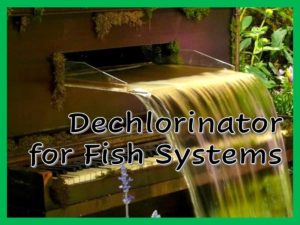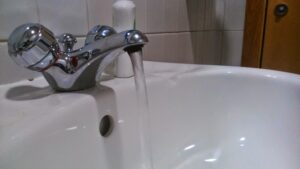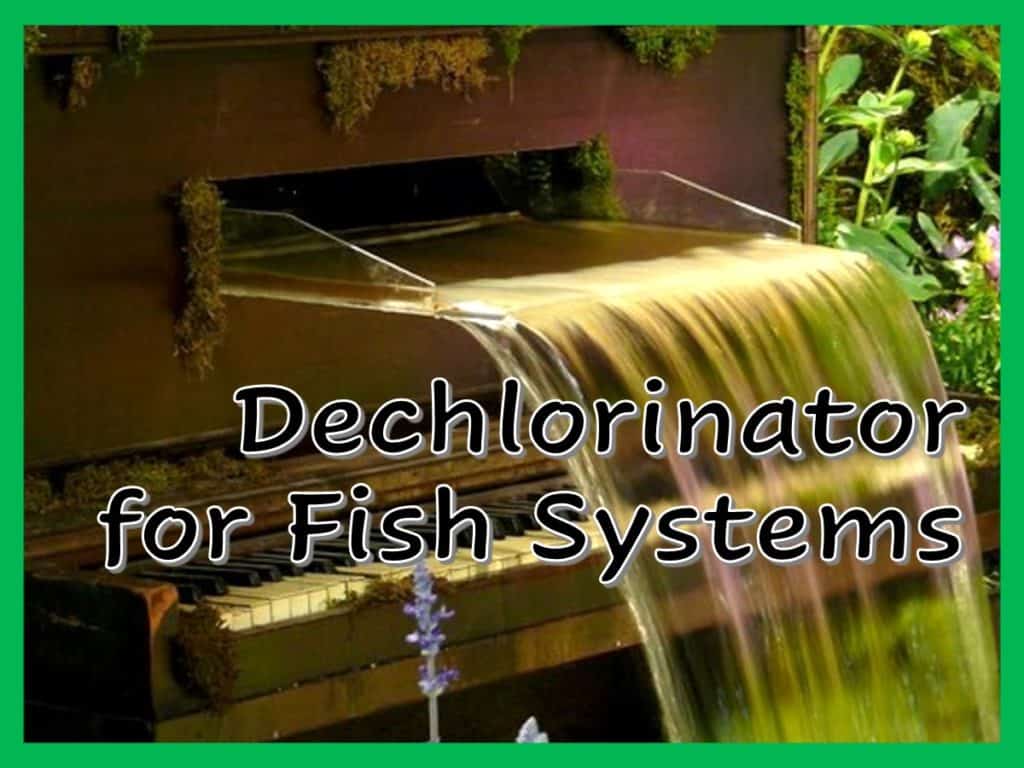** Post contains affiliate links.** Using dechlorinator for fish tanks is a critical part to ensuring your fish system stays healthy. Some pet fish owners may not add dechlorinator regularly, which is not a smart thing to do. Treating your fishes’ water only takes one product and a few extra seconds that can seriously impact your fishes’ lives.

What is dechlorinator?
Dechlorinator for fish tanks and ponds, also known as water conditioner, removes chlorine from your water, making it safe for fish. Some also work on chloramine, a more stable chemical, formed by mixing chlorine and ammonia. Any time you add new tap water to your fish tank or pond, you MUST add a dechlorinator. Failing to do so can quickly kill all of your fish.
There are many commercially available products. Whatever product you use, always follow the instructions. It’s hard to overdose, but you don’t want to waste it. Here is our preferred dechlorinator.
Why should I use dechlorinator for fish systems?
Chlorine is toxic to all fish, causing severe gill damage, leading to asphyxiation and death. Most city water systems use chlorine/chloramine to make water safe for human consumption. You can avoid this if you are on a well system or use bottled water. Keep in mind that some bottled water does not contain the buffers and minerals your fish need.
There is no effective treatment for chlorine poisoning in fish. If they are exposed, it is likely a death sentence. Always use dechlorinator for fish systems.
Most cities don’t dump chlorine or chloramine in their water all the time. They wait for the coliforms to cross a certain threshold and then nuke the system. Just because you’ve never added dechlorinator and never had a problem, does not mean your fish are free and clear!

How does dechlorinator work?
Many dechlorinators contain sodium thiosulfate (H10Na2O8S2), which reacts with the chlorine (Cl2) to produce hydrogen chloride (2HCl), sulfur (S) and sodium sulfate (Na2SO4). Chloride does not harm fish and is safe for the environment.
What about dechlorinators for chloramines?
If you treat water with chloramine just for chlorine, you leave behind the ammonia. If your tank is properly cycling and you aren’t doing heavy water changes, you usually don’t have to worry about the tiny ammonia blip. However, some products go a step further and also remove the ammonia in addition to treating the chlorine.
Taking this one common product as an example, the active ingredient sodium hydroxymethanesulfonate (HOCH2SO3–). (Other brands may use different compounds.) When bound with ammonia (NH3), it forms aminomethanesulfonate (H2NCH2SO3–) and water (H2O). The sulfonate end can combine with chlorine, leaving behind harmless chloride. We’ll get back to ammonia binders in a later blog post.
Is there any “all natural” way to remove chlorine and chloramine?
If adding dechlorinator to your tank isn’t to your liking, you can remove the chlorine and chloramine by using an activated carbon or KDF filter. We had one at our old hospital that made safe water quick and easy. You will need to replace the carbon or filter regularly as the carbon gets used up.
Can’t I just bubble off the chlorine?
If you know for a fact that your water is treated with just chlorine, yes. Adding aeration for about 24 hours will “bubble off” the chlorine, since it is volatile, and make it safe for fish. If your water is treated with chloramine, you can bubble all you like, but it the chloramine isn’t going anywhere.
When should I add my dechlorinator?
If you have a small bucket of water to add to your tank, add the dechlorinator a few minutes prior to moving it to the tank.
If you are adding many gallons through a hose, and do not have a carbon filter attached, we recommend adding a third of the dose before you turn on the hose, another third of the dose at the halfway mark and the final third at the end. Since it is hard to overdose, you can add a little extra at more frequent intervals if you prefer.
The #1 cause of death in older koi = someone leaves the hose on accidentally. Always have a physical reminder! When I worked at the aquarium and was filling a tank, I’d wear my hair elastic around my wrist. The constant annoyance of hair in my face and not liking things on my wrist made it hard to forget I was filling something. Set a timer or force yourself to sit right next to the hose to ensure you do not forget to turn it off!


Pingback: Water Conditioner: 11 Important Things You Should Know (For Beginners) – XtraPets.com
Pingback: How to Build a Home Backyard Pond with Waterfall – Articles Blogs & Videos
Pingback: Best Aquarium Test Kits - Reviews And Buyer's Guide - Ramisp
Pingback: How to clean a 10 gallon fish tank - YourFishTanks.com
Pingback: Is Tap Water Safe for Fish? (6 Ways to Make It Safe for Aquarium)
Great article! It’s important for fish owners to understand the proper way to dechlorinate their water, and this post provides valuable information on how to do so without harming your fish.
Pingback: Brewing Growth: The Only Compost Tea Recipe You Need - Garden Compost Guide